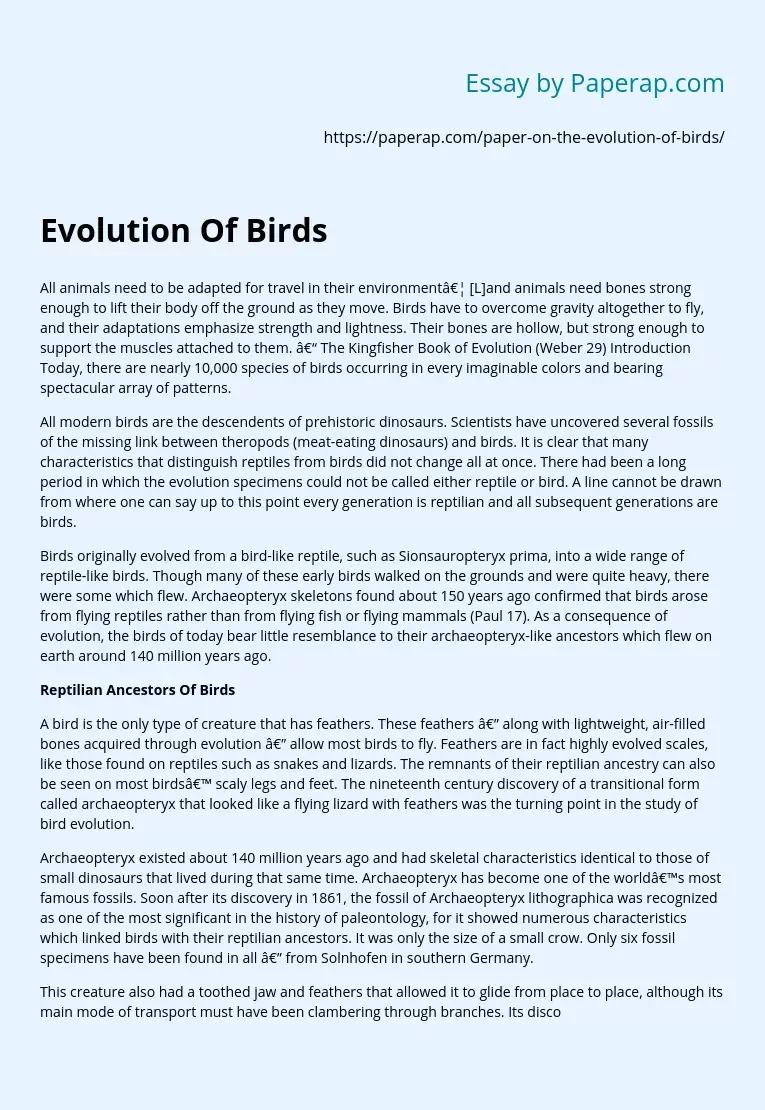Evolution Of Birds
All animals need to be adapted for travel in their environment… [L]and animals need bones strong enough to lift their body off the ground as they move. Birds have to overcome gravity altogether to fly, and their adaptations emphasize strength and lightness. Their bones are hollow, but strong enough to support the muscles attached to them. – The Kingfisher Book of Evolution (Weber 29) Introduction Today, there are nearly 10,000 species of birds occurring in every imaginable colors and bearing spectacular array of patterns.
All modern birds are the descendents of prehistoric dinosaurs. Scientists have uncovered several fossils of the missing link between theropods (meat-eating dinosaurs) and birds. It is clear that many characteristics that distinguish reptiles from birds did not change all at once. There had been a long period in which the evolution specimens could not be called either reptile or bird. A line cannot be drawn from where one can say up to this point every generation is reptilian and all subsequent generations are birds.
Birds originally evolved from a bird-like reptile, such as Sionsauropteryx prima, into a wide range of reptile-like birds. Though many of these early birds walked on the grounds and were quite heavy, there were some which flew. Archaeopteryx skeletons found about 150 years ago confirmed that birds arose from flying reptiles rather than from flying fish or flying mammals (Paul 17). As a consequence of evolution, the birds of today bear little resemblance to their archaeopteryx-like ancestors which flew on earth around 140 million years ago.
Reptilian Ancestors Of Birds
A bird is the only type of creature that has feathers.
These feathers — along with lightweight, air-filled bones acquired through evolution — allow most birds to fly. Feathers are in fact highly evolved scales, like those found on reptiles such as snakes and lizards. The remnants of their reptilian ancestry can also be seen on most birds’ scaly legs and feet. The nineteenth century discovery of a transitional form called archaeopteryx that looked like a flying lizard with feathers was the turning point in the study of bird evolution.
Archaeopteryx existed about 140 million years ago and had skeletal characteristics identical to those of small dinosaurs that lived during that same time. Archaeopteryx has become one of the world’s most famous fossils. Soon after its discovery in 1861, the fossil of Archaeopteryx lithographica was recognized as one of the most significant in the history of paleontology, for it showed numerous characteristics which linked birds with their reptilian ancestors. It was only the size of a small crow. Only six fossil specimens have been found in all — from Solnhofen in southern Germany.
This creature also had a toothed jaw and feathers that allowed it to glide from place to place, although its main mode of transport must have been clambering through branches. Its discovery in 1861, just two years after publication of Charles Darwin’s On the Origin of Species (1859) seemed an unparalleled act of cosmic good will toward science, for by fulfilling the Darwinian expectation that such intermediate forms existed, this one fossil had a profound influence on the ultimate acceptance of the concept of evolution through natural selection.
– The Origin and Evolution of Birds (Feduccia 1) The whole skeleton of the archaeopteryx is essentially like that of small dinosaur. The jaws are not modified into a beak as in modern birds, but are bony and carry numerous undifferentiated teeth. There is no fusion of vertebrae or reduction of the tail which consists of a series of tapering vertebral elements. The breastbone (sternum) carries no keel (a narrow forward-pointing flap) for the attachment of the huge breast muscles necessary for powered flight.
Still it is considered a bird because around the bones of forelimbs and tail are the clear impressions of feathers which are structurally identical to those of modern birds, and feathers are unique to birds. Indeed it is the possession of feathers which defines birds as a class, so that any organism bearing feathers is by definition a bird. About a decade after the discovery of Archaeopteryx, two very different species of toothed birds were discovered in deposits from the Cretaceous period in the western United States. One was name Hesperornis, and the other Ichthyornis (“fish bird”).
The primitive birds found in Europe and America provided the first good evidence for the intermediates between major vertebrate groups that the theory of evolution requires. However, until the recent years, the fossil record from the Mesozoic era (Triassic/Jurassic/Cretaceous) had not been very much to go by. The discovery of archaeopteryx, hesperornis and ichthyornis did not effectively resolve many questions regarding the origins of bird evolution. Only more recent discoveries of some Jurassic and Cretaceous fossils in China have provided strong evidence that birds evolved from a group of dinosaurs known as maniraptorian theropods.
Evolution Of Birds. (2019, Dec 05). Retrieved from https://paperap.com/paper-on-the-evolution-of-birds/

